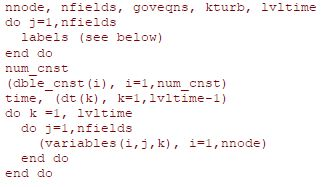The FENSAP binary flow solution file is written with the following structure:

On the first line,
| (32-bit integer) Number of nodes (must be identical to
nnode in the grid file); |
| (32-bit integer) Number of variable fields (6 for Euler, and up to 17 for Navier-Stokes); |
| (32-bit integer) Flag for the governing equations (1 for Euler, 8 for Navier-Stokes); |
| (32-bit integer) Flag for the turbulence model (0 for a laminar flow, 1 for the Spalart-Allmaras one-equation turbulence model, 3 or 4 for kay-epsilon, 5 or 6 for kay-omega); |
| (32-bit integer) Indicates the number of time levels stored in the file. |
The fields are identified by 34-character labels. The first 4 characters of the label are the flow variable key names in FIELDVIEW and the following 30 characters describe the field. The first six labels are always:
DENS - Density (kg/m3 ) PRES - Pressure (N/m2 ) XVELV1 - Velocity (m/s) YVELV2 - Velocity (m/s) ZVELV3 - Velocity (m/s) TEMP - Static temperature (K)
If the flow solution is viscous (goveqns=8) and the
turbulence model is Spalart-Allmaras (kturb=1), the
next six labels are:
KAY - Nutilde (m/s)2 WLDS - Wall distance (m) VISL - Laminar viscosity (kg/m s) VIST - Turbulent viscosity (kg/m s) YPLS - y-plus UPLS - u-plus
Note: When variable surface sand-grain roughness is imposed, the wall distance in the
solution file is replaced with the sand-grain roughness height, whose label is
WLDSroughness height (m). The roughness height
will have non-zero values away from the walls.
If the flow solution is viscous (goveqns=8) and the
turbulence model is k-epsilon (kturb=3 or
kturb=4), the next six labels are:
KAY - Kay (m/s)2 EPSI - Epsilon (m/s2 ) VISL - Laminar viscosity (kg/m s) VIST - Turbulent viscosity (kg/m s) YPLS - y-plus UPLS - u-plus
If the flow solution is viscous (goveqns=8) and the
turbulence model is k-omega (kturb=5 or
kturb=6), the next six labels are:
KAY - Kay (m/s)2 OMEG - Omega (1/s) VISL - Laminar viscosity (kg/m s) VIST - Turbulent viscosity (kg/m s) YPLS - y-plus UPLS - u-plus
If the Navier-Stokes equations have been used to obtain the solution, the solution is complemented by the three components of the shear stress vector, expressed in Pascal (N/m2):
XSFOSF1 - Shear stress (Pa); Shear YSFOSF2 - Shear stress (Pa) ZSFOSF3 - Shear stress (Pa)
If the full energy equation has also been used, the flow solution is complemented by the Classical and Gresho heat fluxes, both expressed in W/m2:
CLAS - Classical heat flux (W/m2 ) GRES - Gresho heat flux (W/m2 )
Note: Heat fluxes are zero everywhere except on wall surfaces.
The values contained in the vector dble_cnst (64-bit
double precision) of length num_cnst (=24 in this
version of FENSAP-ICE) are reference values used to obtain the solution. Some of them are
important for FENSAP, DROP3D and ICE3D:
rgas, gamma, tinf, pinf, machinf, velx, vely, velz, velinf, hinf, xkeinf, rhoinf, p0inf, zmuinf, reinf, prinfnd, entrinf, reinf, omgx, omgy, omgz, zero, zero, zero
| Gas constant |
| Specific heat ratio |
| Reference static temperature |
| Reference static pressure |
| Freestream Mach number |
| X-component of the freestream velocity (non-dimensional) |
| Y-component of the freestream velocity (non-dimensional) |
| Z-component of the freestream velocity (non-dimensional) |
| Magnitude of the freestream velocity |
| Freestream static enthalpy |
| Freestream dynamic pressure (rV2) |
| Reference density |
| Reference total pressure |
| Reference dynamic viscosity |
| Reynolds number |
| Freestream reference pressure (non-dimensional) |
| Freestream reference entropy |
| Effective characteristic length |
| X-component of the rotational velocity |
| Y-component of the rotational velocity |
| Z-component of the rotational velocity |
| Unused (0.0d0) |
| Unused (0.0d0) |
| Unused (0.0d0) |
Next, the time (64-bit double precision) and time steps dt (64-bit double precision) are written. For a steady flow (lvltime=1), this line becomes 0.0d0.
Finally, each variable field (64-bit double precision) is written following the same order as the labels. If the solution was steady-state (lvltime=1) only one time level will be found. For unsteady solutions (lvltime=2 or lvltime=3) two or three time levels of the pressure, velocity components and temperature will be written to the file.
Note: All flow variables are saved in dimensional form, except y_plus and u_plus when the solution has been obtained with the Spalart-Allmaras turbulence model. If the input grid is in cylindrical coordinates, the flow solution is also saved in this reference system.


